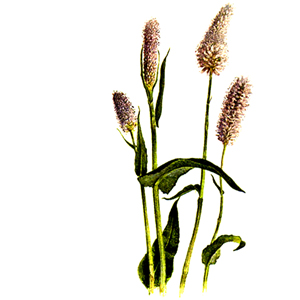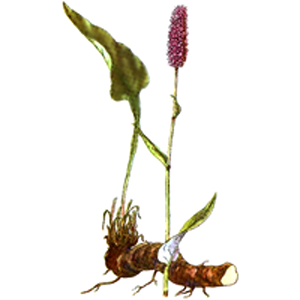No products
Persicaria bistorta - 50g
(Radix Bistortae major)
Persicaria bistorta (Bistorta major) against inflammations of the intestinal mucosa and diarrhea with blood, for dysentery, hepatitis, arthritis, cough, various types of bleeding of the gastrointestinal tract, haemorrhoids, severe menstrual...
![]()
Content |   |
Commonly calledBistort, Common bistort, European bistort or Meadow bistort Latin (botanical) nameBistorta major StorageStore in a dry place at a temperature up to 25°C |
Description of herb
Persicaria bistorta (Bistorta major) - a well-known medicinal herb with strong astringent and anti-inflammatory effects - grows in the subarctic and temperate zone on moist meadows, peat bogs, bogs, floodplain forests and on the banks of streams.
It is scattered, but somewhere it is rare or absent.
Healing effects
Internal use
Due to its tannin content, it is an herb used mainly against inflammation of the intestinal mucosa and diarrhea with a mixture of blood, in dysentery, jaundice, arthritis, cough, sore throat and mouthwash in ulcers.
As a mild sedative and anti-inflammatory and astringent agent in various types of gastrointestinal bleeding, hemorrhoids, heavy menstruation, with a high content of starch, which forms a protective layer on the mucous membranes.
Its administration is suitable for antibiotic treatment, as it can alleviate side effects in the intestinal tract - it prevents the absorption of toxic substances.
It is also used in baths for burns and wet rashes and as a gargle for inflammation of the oral cavity, especially tonsils. In the latter case, it is most often used in the form of tincture. However, it is most often used in the form of decoction.
The drug is astringent and also disinfectant. It is also effective in some forms of leukemia, in anemia, in inflammation of the veins, as a gargle has proven effective for strengthening teeth or in pharyngitis.
External use
Dried rhizome powder, applied externally directly to wounds, will help stop bleeding, including nosebleeds. Root or leaf compresses help relieve the pain of bruises and bites. Externally, it is used to wash hard and poorly healing wounds. Rdesno was used to treat wounds when bitten by vipers. It is also a proven anti-moth agent.
Fruits that are poisonous should be avoided.
Active substances
- The root contains mainly tannins, the content of which is quite fluctuating and usually reaches 10-20%. They are mainly condensed tannins of the catechin type, but also hydrolyzed gal and elag tannins.
- From the therapeutic point of view, the starch content is significant, which is up to 30% in the rhizome.
- It also contains protein (up to 10%), bistort red, small amounts of glucose, emodin, calcium oxalate, vitamin C, mucus, pectin, flobafen and significant amounts of silicic acid.
Properties
Anti-inflammatory, astringent, disinfectant, sedative.
Recommended at
- inflammation of the intestinal mucosa
- diarrhea with blood
- dysentery
- jaundice
- arthritis
- cough
- Sore throat
- for rinsing the mouth in case of ulcers
- gastrointestinal bleeding
- hemorrhoid
- heavy menstruation
- inflammation of the oral cavity
- anemia
- stop bleeding
- poorly healing wounds
Preparation and dosing
Internally
TEA 1: 2 teaspoons of dried cut rhizome boil for 10 minutes in 200 ml of water. Decoction tends to have a more pronounced effect, so it is usually used externally; when used internally, it is drunk only with spoons 2-3 times a day.
TEA 2: 1-2 teaspoons cut drugs per cup of water, drink 2-3 times a day.
POWDER: Root ground to a powder. Three times a day on the tip of a knife.
TINCTURE
Preparation: Load 130 g of dried root into 1 liter of 50% alcohol and let it infuse for 3 weeks. Shake daily.
Dosing: Then drain and use 10-15 drops 3 times a day.
Externally
- For gargling in case of inflammation of the throat and gums
- In the form of compresses for poorly healing wounds
- Dried rhizome powder, applied externally directly to wounds, will help stop bleeding, including nosebleeds
Side effects
The drug is harmless and can be used for a long time at normal doses. Only in sensitive people can a high content of tannins cause the urge to vomit.
REMEMBER: Tell all your health care providers about any complementary health practices you use. Give them a full picture of what you do to manage your health. This will help ensure coordinated and safe care.

